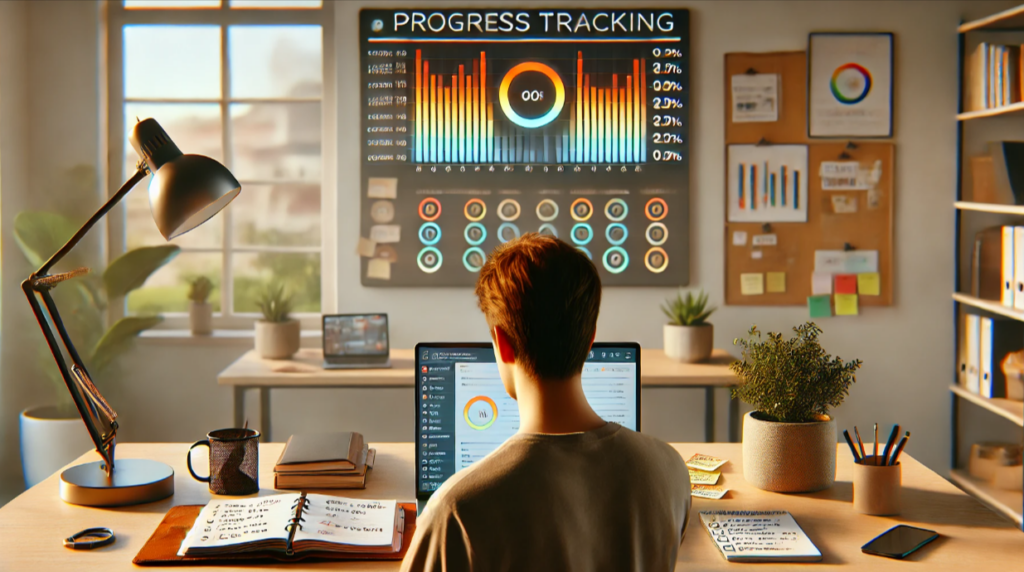In remote work, teams often find themselves spread across different time zones and working on different schedules. This makes synchronous (real-time) communication, like phone calls or video meetings, challenging. That’s where async (asynchronous) communication comes in—it allows team members to respond and contribute at their own pace, without the need for everyone to be online at the same time.
While async communication offers flexibility, it can also lead to challenges in keeping track of who’s doing what and ensuring that everyone is on the same page. In this blog post, we’ll explore how AI-powered tools like Asana, Notion, Upcoach, and more can help remote teams stay accountable, share progress effectively, and maintain strong communication even when they’re not working together in real time.

The Importance of Async Communication in Remote Teams
1. Respecting Diverse Schedules
Imagine a team spread across New York, London, and Sydney. Scheduling a meeting that works for everyone can be nearly impossible. Async communication lets each team member work when they’re most productive, whether that’s in the morning or late at night. This flexibility can boost productivity by 20-25%, according to studies.
2. Promoting Deep Work
Deep work is when you focus on complex tasks without interruptions. With async communication, you can set aside blocks of time to dive into your work without being distracted by constant messages or calls. This focus time is crucial—research from the University of California, Irvine, found that it can take more than 23 minutes to regain focus after being interrupted.
3. Increasing Inclusivity
Async communication also allows everyone on the team to contribute ideas and feedback, not just those who are more vocal in meetings. This inclusivity can lead to better decision-making and more creative solutions, as every team member has time to think and respond thoughtfully.
4. Keeping Each Other Accountable
One of the biggest challenges in remote work is ensuring that everyone stays on track with their tasks and responsibilities, especially when working asynchronously. Without face-to-face interactions, it’s easy for tasks to slip through the cracks, or for team members to lose sight of deadlines.
How Async Communication Helps:
- Transparency: Tools like Asana and Notion provide visibility into everyone’s tasks and progress. When tasks are assigned and tracked in these tools, the whole team can see who is responsible for what and when it’s due. This transparency helps keep everyone accountable because no one wants to be seen as the bottleneck holding up a project.
- Regular Updates: Async communication often involves regular written updates, such as status reports or check-ins. These updates help the team stay informed about each other’s progress and challenges, making it easier to offer support when needed and ensuring that everyone is moving in the same direction.
Example: In a remote marketing team, each member might be responsible for different parts of a campaign—one person handles social media, another manages email marketing, and a third works on content creation. By using Asana to track tasks and deadlines, each team member can see the progress of the entire campaign. If someone falls behind, it’s immediately visible, and the team can step in to help or adjust their work accordingly. This kind of accountability ensures that the campaign stays on track and that everyone is contributing their fair share.
Statistic: According to a survey by Buffer, 21% of remote workers say that collaboration and communication are their biggest struggles. Async tools help alleviate this by making it easier to hold each other accountable without constant meetings.

AI-Powered Tools to Enhance Async Communication
1. Asana: Streamlining Task Management and Accountability
Asana is a project management tool that helps teams organize tasks, set deadlines, and track progress. It’s particularly useful for async communication because:
- Task Prioritization: Asana uses AI to suggest which tasks should be tackled first based on their deadlines and importance. This helps ensure that the most critical work is done on time.
- Progress Reports: Asana’s reporting features let you see how a project is progressing at a glance. For example, you can quickly see how many tasks have been completed and what still needs to be done, helping you spot any bottlenecks early.
- Automated Reminders: If a task’s deadline is approaching, Asana can automatically send reminders to the responsible team members, helping them stay on track without needing constant check-ins.
Example: Let’s say your team is launching a new product. You can create a project in Asana with all the tasks that need to be completed—like designing the product, creating marketing materials, and setting up the website. Each task is assigned to a team member with a deadline. As team members complete their tasks, Asana updates the project’s progress automatically, so everyone knows what’s been done and what’s left to do.
Statistic: A report from Asana found that teams using their platform are 45% more likely to deliver projects on time.
2. Notion: Centralizing Information and Enhancing Collaboration
Notion is a versatile tool that combines notes, databases, and tasks in one place. It’s perfect for async communication because:
- Documentation: You can document everything in Notion, from meeting notes to project plans, so everyone on the team can access the information they need, whenever they need it.
- Collaborative Databases: Notion lets you create databases to manage and share knowledge across the team. For example, you could create a database of company guidelines, project updates, or client information that everyone can update and refer to.
- AI-Powered Organization: Notion’s AI can help organize your content, making it easier to find the documents you need. It can even suggest related documents or templates based on what you’re working on.
Example: Suppose your team is working on a new marketing campaign. You can create a Notion page where you gather all your ideas, research, and strategies. Each team member can add their contributions when they’re ready, and everyone can see the latest updates in real-time.
Statistic: According to a survey, 90% of Notion users reported that the tool helped them better manage their work and stay organized.
3. Upcoach: Facilitating Continuous Learning and Development
Upcoach is designed to help teams with coaching, training, and continuous development. It’s an excellent tool for async communication because:
- Automated Learning Paths: Upcoach uses AI to recommend learning materials based on what you’ve already completed and your team’s overall goals. This means team members can continuously improve their skills at their own pace.
- Progress Tracking: Upcoach tracks each person’s progress through their learning paths, providing feedback and encouraging accountability. Team leaders can see who’s completed their training and who might need extra help.
- Customizable Templates: Upcoach offers templates for regular check-ins and goal tracking, which can be customized to fit your team’s needs. This helps ensure that everyone stays aligned with their goals, even in an async environment.
Example: If your team needs to learn about a new software tool, Upcoach can create a learning path with videos, articles, and quizzes. Team members can complete the training when it fits into their schedule, and Upcoach will track their progress and remind them of any unfinished tasks.
Statistic: A study found that companies using structured learning tools like Upcoach see a 24% increase in productivity.
4. Slack and AI Bots: Enhancing Communication and Accountability
Slack is a communication tool that supports both real-time and async messaging. While it’s known for its chat features, it also has async capabilities like:
- Scheduled Messages: You can schedule messages to be sent at the most appropriate time, ensuring that important updates don’t get lost in the shuffle.
- AI Bots for Progress Tracking: Slack has AI bots like Geekbot that can automate routine check-ins. For example, Geekbot can ask team members what they’re working on and then compile the responses into a report, which everyone can review asynchronously.
Example: If your team has a weekly check-in on Slack, you can use Geekbot to ask each member to summarize their progress at the end of the week. Geekbot then compiles these summaries into a single report that everyone can read when they have time, reducing the need for a live meeting.
Statistic: Teams using AI bots like Geekbot report a 30% increase in transparency and communication efficiency.

Best Practices for Async Communication
1. Set Clear Expectations
Make sure everyone on your team knows what needs immediate attention and what can wait. This helps prevent confusion and ensures that important tasks don’t get delayed.
Example: Use Notion to create a guideline document that outlines response time expectations for different types of communication. For instance, emails might need a response within 24 hours, while project updates can be reviewed within 48 hours.
2. Use Clear and Concise Communication
In async communication, your messages need to be clear and easy to understand. Avoid jargon and be as straightforward as possible to reduce the need for follow-up questions.
Example: When assigning tasks in Asana, write detailed descriptions that include all necessary information, such as deadlines, goals, and any resources needed. This way, the team member can complete the task without needing to ask for clarification.
3. Document Everything
Keep a record of all decisions, processes, and updates in a central place like Notion. This ensures that everyone can access the information they need at any time.
Example: After a project meeting, document the key decisions and action items in a shared Notion page. This allows team members who couldn’t attend the meeting to stay informed and contribute asynchronously.
4. Regularly Review Progress
Use tools like Asana to track the progress of your projects and ensure everyone is on the same page. Regular reviews help identify any potential issues early and keep the project on track.
Example: Schedule a monthly review in Asana where you go over the project’s progress, upcoming deadlines, and any tasks that are behind schedule. This review can be done asynchronously, with each team member adding their updates before a set deadline.
How Our Virtual Assistants Excel in Async Communication
At TaskDrive, we understand the importance of effective async communication, especially when managing remote teams. That’s why our Virtual Assistants (VAs) are fully trained and equipped to excel in this environment.
Our VAs utilize Upcoach for tracking their tasks and professional development. This tool allows them to follow structured learning paths and stay on top of their tasks with automated reminders and progress tracking. Additionally, we maintain daily communication with our VAs through Google Chat, ensuring that any updates or questions are handled promptly, even in an asynchronous setting.
By combining these tools, our VAs can stay accountable, manage their time effectively, and ensure that your projects stay on track, regardless of time zones or schedules. Whether you need help with administrative tasks, project management, or customer support, our VAs are prepared to work seamlessly with your team in an async environment, keeping everything running smoothly and efficiently.
If you’re interested in learning more about how our AI-Augmented Virtual Assistants can support your business: Get in touch today to start the conversation.



